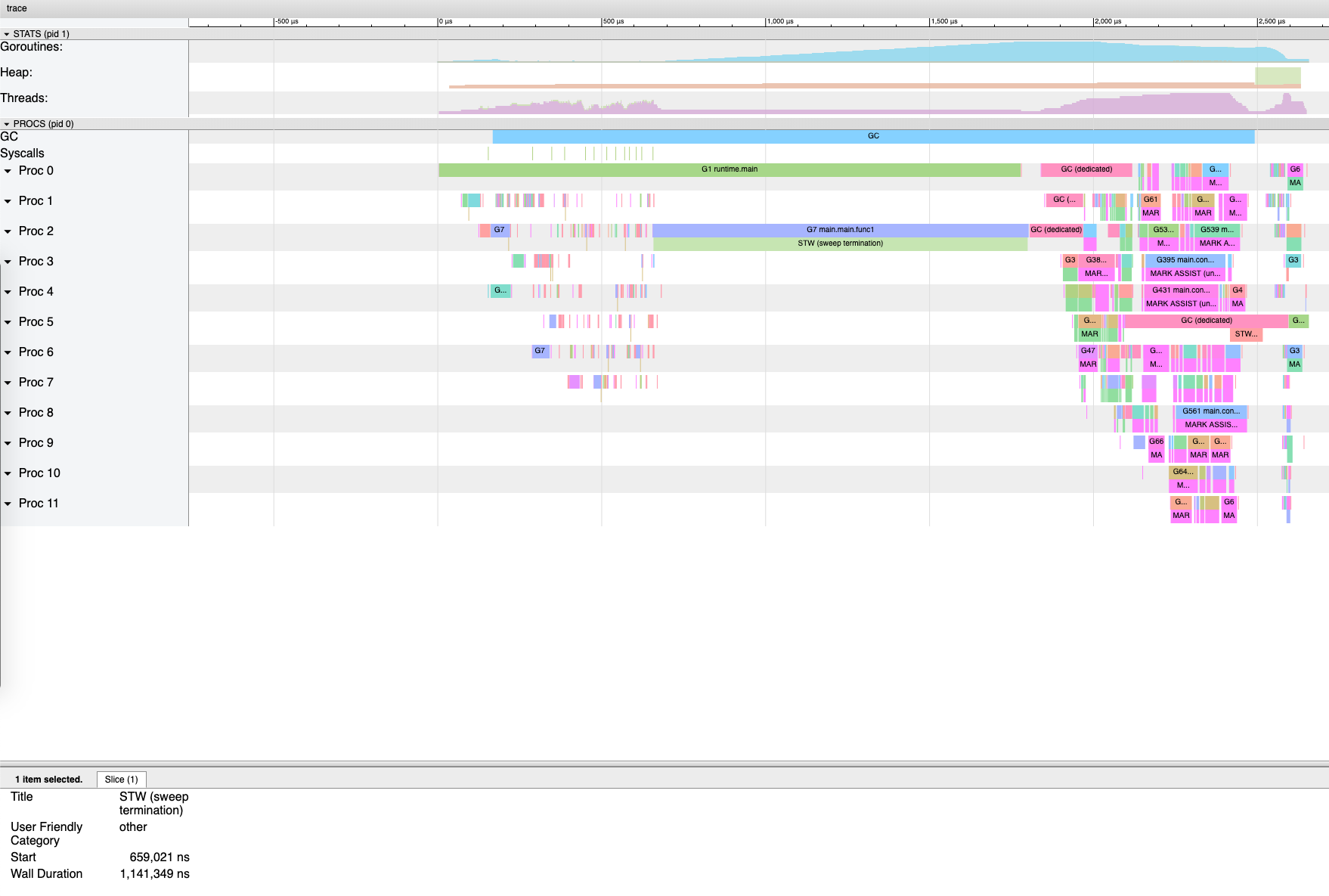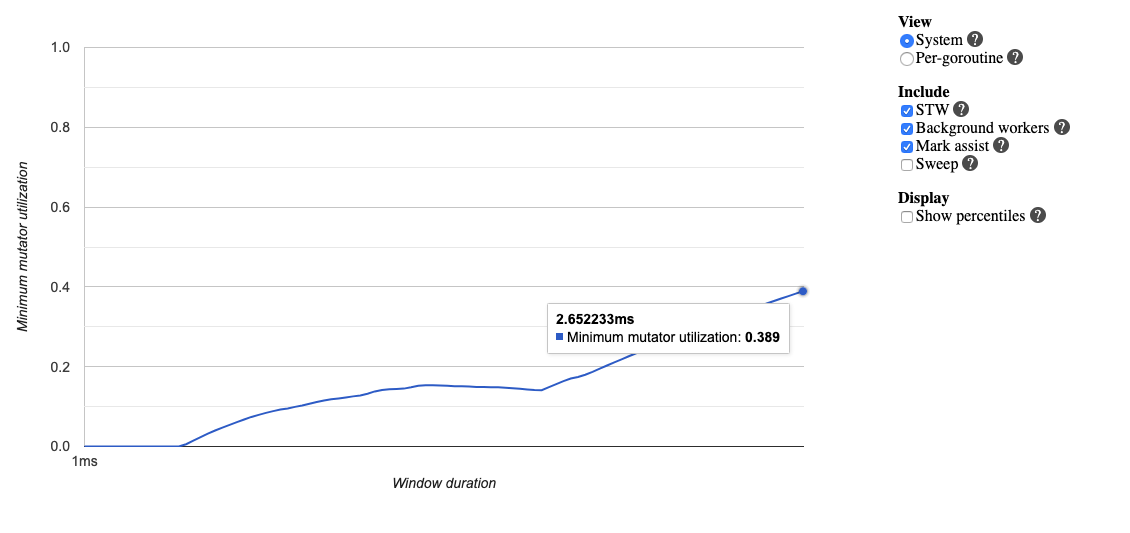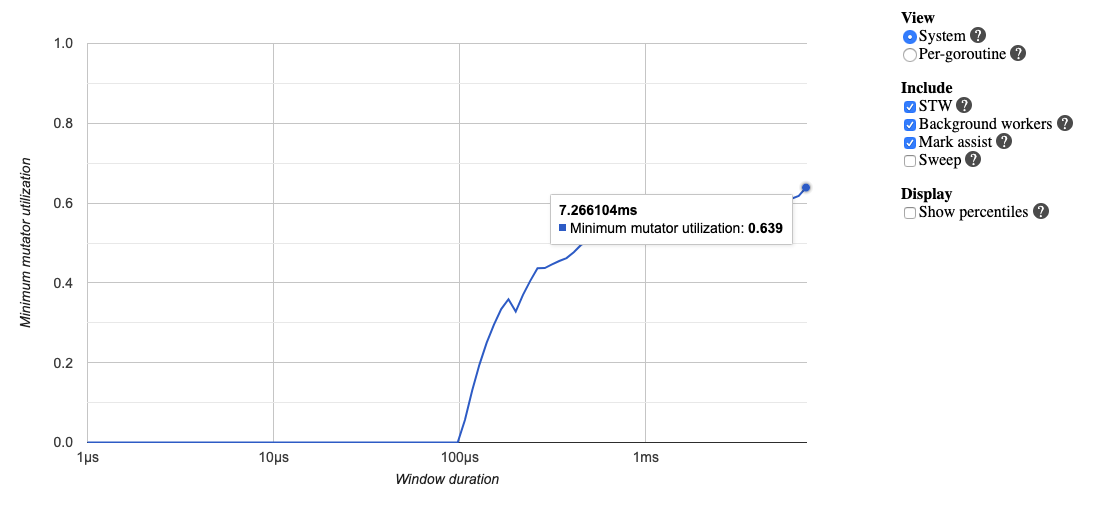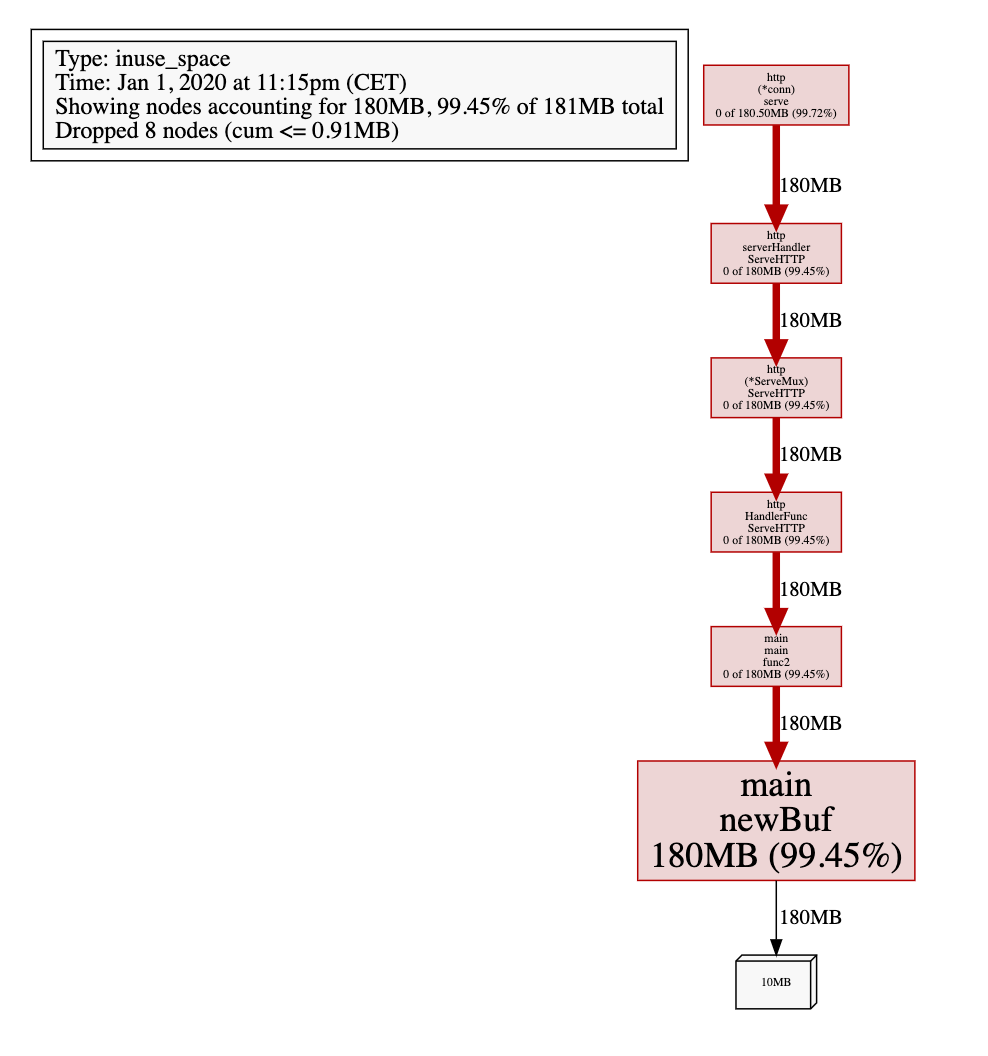14. Go 的 GC 如何调优?
Go 的 GC 被设计为极致简洁,与较为成熟的 Java GC 的数十个可控参数相比,严格意义上来讲,Go 可供用户调整的参数只有 GOGC 环境变量。当我们谈论 GC 调优时,通常是指减少用户代码对 GC 产生的压力,这一方面包含了减少用户代码分配内存的数量(即对程序的代码行为进行调优),另一方面包含了最小化 Go 的 GC 对 CPU 的使用率(即调整 GOGC)。
GC 的调优是在特定场景下产生的,并非所有程序都需要针对 GC 进行调优。只有那些对执行延迟非常敏感、当 GC 的开销成为程序性能瓶颈的程序,才需要针对 GC 进行性能调优,几乎不存在于实际开发中 99% 的情况。除此之外,Go 的 GC 也仍然有一定的可改进的空间,也有部分 GC 造成的问题,目前仍属于 Open Problem。
总的来说,我们可以在现在的开发中处理的有以下几种情况:
- 对停顿敏感:GC 过程中产生的长时间停顿、或由于需要执行 GC 而没有执行用户代码,导致需要立即执行的用户代码执行滞后。
- 对资源消耗敏感:对于频繁分配内存的应用而言,频繁分配内存增加 GC 的工作量,原本可以充分利用 CPU 的应用不得不频繁地执行垃圾回收,影响用户代码对 CPU 的利用率,进而影响用户代码的执行效率。
从这两点来看,所谓 GC 调优的核心思想也就是充分的围绕上面的两点来展开:优化内存的申请速度,尽可能的少申请内存,复用已申请的内存。或者简单来说,不外乎这三个关键字:控制、减少、复用。
我们将通过三个实际例子介绍如何定位 GC 的存在的问题,并一步一步进行性能调优。当然,在实际情况中问题远比这些例子要复杂,这里也只是讨论调优的核心思想,更多的时候也只能具体问题具体分析。
例 1:合理化内存分配的速度、提高赋值器的 CPU 利用率
我们来看这样一个例子。在这个例子中,concat 函数负责拼接一些长度不确定的字符串。并且为了快速完成任务,出于某种原因,在两个嵌套的 for 循环中一口气创建了 800 个 goroutine。在 main 函数中,启动了一个 goroutine 并在程序结束前不断的触发 GC,并尝试输出 GC 的平均执行时间:
1. `package main`3. `import (`4. `"fmt"`5. `"os"`6. `"runtime"`7. `"runtime/trace"`8. `"sync/atomic"`9. `"time"`10. `)`12. `var (`13. `stop int32`14. `count int64`15. `sum time.Duration`16. `)`18. `func concat() {`19. `for n := 0; n < 100; n++ {`20. `for i := 0; i < 8; i++ {`21. `go func() {`22. `s := "Go GC"`23. `s += " " + "Hello"`24. `s += " " + "World"`25. `_ = s`26. `}()`27. `}`28. `}`29. `}`31. `func main() {`32. `f, _ := os.Create("trace.out")`33. `defer f.Close()`34. `trace.Start(f)`35. `defer trace.Stop()`37. `go func() {`38. `var t time.Time`39. `for atomic.LoadInt32(&stop) == 0 {`40. `t = time.Now()`41. `runtime.GC()`42. `sum += time.Since(t)`43. `count++`44. `}`45. `fmt.Printf("GC spend avg: %v\n", time.Duration(int64(sum)/count))`46. `}()`48. `concat()`49. `atomic.StoreInt32(&stop, 1)`50. `}`
这个程序的执行结果是:
1. `$ go build -o main`2. `$ ./main`3. `GC spend avg: 2.583421ms`
GC 平均执行一次需要长达 2ms 的时间,我们再进一步观察 trace 的结果:

程序的整个执行过程中仅执行了一次 GC,而且仅 Sweep STW 就耗费了超过 1 ms,非常反常。甚至查看赋值器 mutator 的 CPU 利用率,在整个 trace 尺度下连 40% 都不到:

主要原因是什么呢?我们不妨查看 goroutine 的分析:

在这个榜单中我们不难发现,goroutine 的执行时间占其生命周期总时间非常短的一部分,但大部分时间都花费在调度器的等待上了(蓝色的部分),说明同时创建大量 goroutine 对调度器产生的压力确实不小,我们不妨将这一产生速率减慢,一批一批地创建 goroutine:
1. `func concat() {`2. `wg := sync.WaitGroup{}`3. `for n := 0; n < 100; n++ {`4. `wg.Add(8)`5. `for i := 0; i < 8; i++ {`6. `go func() {`7. `s := "Go GC"`8. `s += " " + "Hello"`9. `s += " " + "World"`10. `_ = s`11. `wg.Done()`12. `}()`13. `}`14. `wg.Wait()`15. `}`16. `}`
这时候我们再来看:
1. `$ go build -o main`2. `$ ./main`3. `GC spend avg: 328.54µs`
GC 的平均时间就降到 300 微秒了。这时的赋值器 CPU 使用率也提高到了 60%,相对来说就很可观了:

当然,这个程序仍然有优化空间,例如我们其实没有必要等待很多 goroutine 同时执行完毕才去执行下一组 goroutine。而可以当一个 goroutine 执行完毕时,直接启动一个新的 goroutine,也就是 goroutine 池的使用。有兴趣的读者可以沿着这个思路进一步优化这个程序中赋值器对 CPU 的使用率。
例 2:降低并复用已经申请的内存
我们通过一个非常简单的 Web 程序来说明复用内存的重要性。在这个程序中,每当产生一个 /example2的请求时,都会创建一段内存,并用于进行一些后续的工作。
1. `package main`3. `import (`4. `"fmt"`5. `"net/http"`6. `_ "net/http/pprof"`7. `)`9. `func newBuf() []byte {`10. `return make([]byte, 10<<20)`11. `}`13. `func main() {`14. `go func() {`15. `http.ListenAndServe("localhost:6060", nil)`16. `}()`18. `http.HandleFunc("/example2", func(w http.ResponseWriter, r *http.Request) {`19. `b := newBuf()`21. `// 模拟执行一些工作`22. `for idx := range b {`23. `b[idx] = 1`24. `}`26. `fmt.Fprintf(w, "done, %v", r.URL.Path[1:])`27. `})`28. `http.ListenAndServe(":8080", nil)`29. `}`
为了进行性能分析,我们还额外创建了一个监听 6060 端口的 goroutine,用于使用 pprof 进行分析。我们先让服务器跑起来:
1. `$ go build -o main`2. `$ ./main`
我们这次使用 pprof 的 trace 来查看 GC 在此服务器中面对大量请求时候的状态,要使用 trace 可以通过访问 /debug/pprof/trace 路由来进行,其中 seconds 参数设置为 20s,并将 trace 的结果保存为 trace.out:
1. `$ wget http://127.0.0.1:6060/debug/pprof/trace\?seconds\=20 -O trace.out`2. `--2020-01-01 22:13:34-- http://127.0.0.1:6060/debug/pprof/trace?seconds=20`3. `Connecting to 127.0.0.1:6060... connected.`4. `HTTP request sent, awaiting response...`
这时候我们使用一个压测工具 ab,来同时产生 500 个请求(-n 一共 500 个请求,-c 一个时刻执行请求的数量,每次 100 个并发请求):
1. `$ ab -n 500 -c 100 http://127.0.0.1:8080/example2`2. `This is ApacheBench, Version 2.3 <$Revision: 1843412 $>`3. `Copyright 1996 Adam Twiss, Zeus Technology Ltd, http://www.zeustech.net/`4. `Licensed to The Apache Software Foundation, http://www.apache.org/`6. `Benchmarking 127.0.0.1 (be patient)`7. `Completed 100 requests`8. `Completed 200 requests`9. `Completed 300 requests`10. `Completed 400 requests`11. `Completed 500 requests`12. `Finished 500 requests`15. `Server Software:`16. `Server Hostname: 127.0.0.1`17. `Server Port: 8080`19. `Document Path: /example2`20. `Document Length: 14 bytes`22. `Concurrency Level: 100`23. `Time taken for tests: 0.987 seconds`24. `Complete requests: 500`25. `Failed requests: 0`26. `Total transferred: 65500 bytes`27. `HTML transferred: 7000 bytes`28. `Requests per second: 506.63 [#/sec] (mean)`29. `Time per request: 197.382 [ms] (mean)`30. `Time per request: 1.974 [ms] (mean, across all concurrent requests)`31. `Transfer rate: 64.81 [Kbytes/sec] received`33. `Connection Times (ms)`34. `min mean[+/-sd] median max`35. `Connect: 0 1 1.1 0 7`36. `Processing: 13 179 77.5 170 456`37. `Waiting: 10 168 78.8 162 455`38. `Total: 14 180 77.3 171 458`40. `Percentage of the requests served within a certain time (ms)`41. `50% 171`42. `66% 203`43. `75% 222`44. `80% 239`45. `90% 281`46. `95% 335`47. `98% 365`48. `99% 400`49. `100% 458 (longest request)`

GC 反复被触发,一个显而易见的原因就是内存分配过多。我们可以通过 go tool pprof 来查看究竟是谁分配了大量内存(使用 web 指令来使用浏览器打开统计信息的可视化图形):
1. `$ go tool pprof http://127.0.0.1:6060/debug/pprof/heap`2. `Fetching profile over HTTP from http://localhost:6060/debug/pprof/heap`3. `Saved profile in /Users/changkun/pprof/pprof.alloc_objects.alloc_space.inuse_o`4. `bjects.inuse_space.003.pb.gz`5. `Type: inuse_space`6. `Time: Jan 1, 2020 at 11:15pm (CET)`7. `Entering interactive mode (type "help" for commands, "o" for options)`8. `(pprof) web`9. `(pprof)`

可见 newBuf 产生的申请的内存过多,现在我们使用 sync.Pool 来复用 newBuf 所产生的对象:
1. `package main`3. `import (`4. `"fmt"`5. `"net/http"`6. `_ "net/http/pprof"`7. `"sync"`8. `)`10. `// 使用 sync.Pool 复用需要的 buf`11. `var bufPool = sync.Pool{`12. `New: func() interface{} {`13. `return make([]byte, 10<<20)`14. `},`15. `}`17. `func main() {`18. `go func() {`19. `http.ListenAndServe("localhost:6060", nil)`20. `}()`21. `http.HandleFunc("/example2", func(w http.ResponseWriter, r *http.Request) {`22. `b := bufPool.Get().([]byte)`23. `for idx := range b {`24. `b[idx] = 0`25. `}`26. `fmt.Fprintf(w, "done, %v", r.URL.Path[1:])`27. `bufPool.Put(b)`28. `})`29. `http.ListenAndServe(":8080", nil)`30. `}`
其中 ab 输出的统计结果为:
1. `$ ab -n 500 -c 100 http://127.0.0.1:8080/example2`2. `This is ApacheBench, Version 2.3 <$Revision: 1843412 $>`3. `Copyright 1996 Adam Twiss, Zeus Technology Ltd, http://www.zeustech.net/`4. `Licensed to The Apache Software Foundation, http://www.apache.org/`6. `Benchmarking 127.0.0.1 (be patient)`7. `Completed 100 requests`8. `Completed 200 requests`9. `Completed 300 requests`10. `Completed 400 requests`11. `Completed 500 requests`12. `Finished 500 requests`15. `Server Software:`16. `Server Hostname: 127.0.0.1`17. `Server Port: 8080`19. `Document Path: /example2`20. `Document Length: 14 bytes`22. `Concurrency Level: 100`23. `Time taken for tests: 0.427 seconds`24. `Complete requests: 500`25. `Failed requests: 0`26. `Total transferred: 65500 bytes`27. `HTML transferred: 7000 bytes`28. `Requests per second: 1171.32 [#/sec] (mean)`29. `Time per request: 85.374 [ms] (mean)`30. `Time per request: 0.854 [ms] (mean, across all concurrent requests)`31. `Transfer rate: 149.85 [Kbytes/sec] received`33. `Connection Times (ms)`34. `min mean[+/-sd] median max`35. `Connect: 0 1 1.4 1 9`36. `Processing: 5 75 48.2 66 211`37. `Waiting: 5 72 46.8 63 207`38. `Total: 5 77 48.2 67 211`40. `Percentage of the requests served within a certain time (ms)`41. `50% 67`42. `66% 89`43. `75% 107`44. `80% 122`45. `90% 148`46. `95% 167`47. `98% 196`48. `99% 204`49. `100% 211 (longest request)`
但从 Requests per second 每秒请求数来看,从原来的 506.63 变为 1171.32 得到了近乎一倍的提升。从 trace 的结果来看,GC 也没有频繁的被触发从而长期消耗 CPU 使用率:

sync.Pool 是内存复用的一个最为显著的例子,从语言层面上还有很多类似的例子,例如在例 1 中,concat 函数可以预先分配一定长度的缓存,而后再通过 append 的方式将字符串存储到缓存中:
1. `func concat() {`2. `wg := sync.WaitGroup{}`3. `for n := 0; n < 100; n++ {`4. `wg.Add(8)`5. `for i := 0; i < 8; i++ {`6. `go func() {`7. `s := make([]byte, 0, 20)`8. `s = append(s, "Go GC"...)`9. `s = append(s, ' ')`10. `s = append(s, "Hello"...)`11. `s = append(s, ' ')`12. `s = append(s, "World"...)`13. `_ = string(s)`14. `wg.Done()`15. `}()`16. `}`17. `wg.Wait()`18. `}`19. `}`
原因在于 + 运算符会随着字符串长度的增加而申请更多的内存,并将内容从原来的内存位置拷贝到新的内存位置,造成大量不必要的内存分配,先提前分配好足够的内存,再慢慢地填充,也是一种减少内存分配、复用内存形式的一种表现。
例 3:调整 GOGC
我们已经知道了 GC 的触发原则是由步调算法来控制的,其关键在于估计下一次需要触发 GC 时,堆的大小。可想而知,如果我们在遇到海量请求的时,为了避免 GC 频繁触发,是否可以通过将 GOGC 的值设置得更大,让 GC 触发的时间变得更晚,从而减少其触发频率,进而增加用户代码对机器的使用率呢?答案是肯定的。
我们可以非常简单粗暴的将 GOGC 调整为 1000,来执行上一个例子中未复用对象之前的程序:
1. `$ GOGC=1000 ./main`
这时我们再重新执行压测:
1. `$ ab -n 500 -c 100 http://127.0.0.1:8080/example2`2. `This is ApacheBench, Version 2.3 <$Revision: 1843412 $>`3. `Copyright 1996 Adam Twiss, Zeus Technology Ltd, http://www.zeustech.net/`4. `Licensed to The Apache Software Foundation, http://www.apache.org/`6. `Benchmarking 127.0.0.1 (be patient)`7. `Completed 100 requests`8. `Completed 200 requests`9. `Completed 300 requests`10. `Completed 400 requests`11. `Completed 500 requests`12. `Finished 500 requests`15. `Server Software:`16. `Server Hostname: 127.0.0.1`17. `Server Port: 8080`19. `Document Path: /example2`20. `Document Length: 14 bytes`22. `Concurrency Level: 100`23. `Time taken for tests: 0.923 seconds`24. `Complete requests: 500`25. `Failed requests: 0`26. `Total transferred: 65500 bytes`27. `HTML transferred: 7000 bytes`28. `Requests per second: 541.61 [#/sec] (mean)`29. `Time per request: 184.636 [ms] (mean)`30. `Time per request: 1.846 [ms] (mean, across all concurrent requests)`31. `Transfer rate: 69.29 [Kbytes/sec] received`33. `Connection Times (ms)`34. `min mean[+/-sd] median max`35. `Connect: 0 1 1.8 0 20`36. `Processing: 9 171 210.4 66 859`37. `Waiting: 5 158 199.6 62 813`38. `Total: 9 173 210.6 68 860`40. `Percentage of the requests served within a certain time (ms)`41. `50% 68`42. `66% 133`43. `75% 198`44. `80% 292`45. `90% 566`46. `95% 696`47. `98% 723`48. `99% 743`49. `100% 860 (longest request)`
可以看到,压测的结果得到了一定幅度的改善(Requests per second 从原来的 506.63 提高为了 541.61),并且 GC 的执行频率明显降低:

在实际实践中可表现为需要紧急处理一些由 GC 带来的瓶颈时,人为将 GOGC 调大,加钱加内存,扛过这一段峰值流量时期。
当然,这种做法其实是治标不治本,并没有从根本上解决内存分配过于频繁的问题,极端情况下,反而会由于 GOGC 太大而导致回收不及时而耗费更多的时间来清理产生的垃圾,这对时间不算敏感的应用还好,但对实时性要求较高的程序来说就是致命的打击了。
因此这时更妥当的做法仍然是,定位问题的所在,并从代码层面上进行优化。
小结
通过上面的三个例子我们可以看到在 GC 调优过程中 go tool pprof 和 go tool trace 的强大作用是帮助我们快速定位 GC 导致瓶颈的具体位置,但这些例子中仅仅覆盖了其功能的很小一部分,我们也没有必要完整覆盖所有的功能,因为总是可以通过 http pprof 官方文档[7]、runtime pprof 官方文档[8]以及 trace 官方文档[9]来举一反三。
现在我们来总结一下前面三个例子中的优化情况:
- 控制内存分配的速度,限制 goroutine 的数量,从而提高赋值器对 CPU 的利用率。
- 减少并复用内存,例如使用 sync.Pool 来复用需要频繁创建临时对象,例如提前分配足够的内存来降低多余的拷贝。
- 需要时,增大 GOGC 的值,降低 GC 的运行频率。
这三种情况几乎涵盖了 GC 调优中的核心思路,虽然从语言上还有很多小技巧可说,但我们并不会在这里事无巨细的进行总结。实际情况也是千变万化,我们更应该着重于培养具体问题具体分析的能力。
当然,我们还应该谨记 过早优化是万恶之源这一警语,在没有遇到应用的真正瓶颈时,将宝贵的时间分配在开发中其他优先级更高的任务上。
https://www.bookstack.cn/read/qcrao-Go-Questions/spilt.14.GC-GC.md

